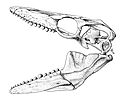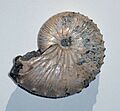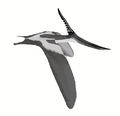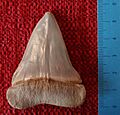List of the prehistoric life of Delaware facts for kids
The state of Delaware might seem small, but it has a long and exciting history hidden deep within its rocks! This history is told by fossils, which are the preserved remains or traces of ancient life. Scientists have found many different kinds of fossils in Delaware, showing us what animals and plants lived here millions of years ago.
Some of these fossils are from tiny sea creatures, while others are from huge dinosaurs and ancient sharks. Studying these fossils helps us understand how life on Earth has changed over vast amounts of time. It also tells us what Delaware was like in the past, from ancient seas to prehistoric lands.
Prehistoric Eras in Delaware
Scientists divide Earth's history into huge time periods called eras. When we look at Delaware's fossil record, we find that some eras have more fossils than others.
Precambrian and Paleozoic Eras
The Paleobiology Database is a big collection of information about fossils. According to their records, scientists have not yet found any fossils from the very early Precambrian or Paleozoic eras in Delaware. This means that either no life was preserved here during those times, or the rocks from those periods are not easily found or studied in Delaware.
Mesozoic Era: The Age of Dinosaurs
The Mesozoic Era, often called the "Age of Dinosaurs," lasted from about 252 to 66 million years ago. During this time, Delaware was often covered by a warm, shallow sea. This means many of the fossils found here are from marine (ocean) animals.
Dinosaurs and Flying Reptiles
Even though Delaware was mostly underwater, some dinosaur fossils have been found. These likely came from land animals that washed out to sea after they died.
- †Coelosaurus: This was a small, fast-running dinosaur.
- †Dryptosaurus: This was a large, meat-eating dinosaur, similar to T. rex but living earlier.
- †Ornithomimus: This dinosaur looked a bit like an ostrich, with long legs and a small head.
Flying reptiles called Pterosaurs also soared through the skies.
- †Pteranodon: This was a very large flying reptile with a long crest on its head. Its fossils are a tentative report, meaning more study is needed.
Marine Reptiles
The ancient seas of Delaware were home to powerful marine reptiles.
- †Clidastes: A type of Mosasaur, which were giant, lizard-like marine predators.
- †Globidens: Another mosasaur, but with round, blunt teeth perfect for crushing hard-shelled prey.
- †Tylosaurus: One of the largest and most fearsome mosasaurs, reaching lengths of over 40 feet!
- †Toxochelys: An ancient sea turtle that swam in these waters.
Ancient Fish and Sharks
The Mesozoic seas were full of fish and sharks.
- †Apsopelix: A type of bony fish.
- †Enchodus: Known as the "saber-toothed herring" because of its long, sharp fangs.
- †Xiphactinus: A huge, predatory bony fish that could grow up to 17 feet long.
- †Cretolamna: An ancient shark, related to modern mackerel sharks.
- †Hybodus: A prehistoric shark with two dorsal fins and sharp teeth.
- Squalicorax: Also known as the "crow shark," this shark was a scavenger and predator.
Shells and Other Sea Creatures
Many fossils found in Delaware are from invertebrates, animals without backbones, like clams, snails, and ammonites.
- †Baculites: A type of Ammonite (a shelled cephalopod, related to modern squid and octopuses) with a straight, uncoiled shell.
- †Belemnitella: A type of Belemnite, another cephalopod that looked like a squid with an internal shell.
- †Didymoceras: A unique ammonite with a shell that coiled in an irregular, spiral shape.
- †Exogyra: A type of oyster with a very thick, twisted shell.
- †Inoceramus: A very large clam that could grow to several feet across.
- †Jeletzkytes: Another type of ammonite with a coiled shell.
- †Turritella: A common sea snail with a tall, spiral shell.
Cenozoic Era: The Age of Mammals
The Cenozoic Era began about 66 million years ago and continues to the present day. After the dinosaurs died out, mammals became the dominant large animals on Earth. Delaware's landscape changed, with seas receding and then returning, leaving behind different types of fossils.
Ancient Mammals
Many interesting mammal fossils have been found in Delaware, including ancient relatives of horses and dogs.
- †Amphicyon: Known as a "beardog," this animal was a large, powerful predator that looked like a mix between a bear and a dog.
- †Anchitherium: An early horse relative, smaller than modern horses and with three toes on each foot.
- †Archaeohippus: Another ancient horse, even smaller than Anchitherium.
- †Cynelos: Another type of beardog.
- †Metatomarctus: An ancient dog-like mammal.
- †Parahippus: A horse ancestor that lived in forests and ate leaves.
- †Tylocephalonyx: A strange mammal called a Chalicothere, which had large claws instead of hooves.
Marine Mammals
The Cenozoic seas of Delaware were home to ancient whales and seals.
- †Leptophoca: An early type of seal.
- †Schizodelphis: An ancient toothed whale.
- †Squalodon: A "shark-toothed dolphin," an early whale with teeth similar to those of sharks.
Sharks and Other Fish
Sharks continued to thrive in the Cenozoic seas.
- Carcharhinus: Modern-looking sharks, including species related to bull sharks and blacktip sharks.
- †Carcharodon hastalis: An ancient shark, sometimes called the "broad-toothed mako," which was a large and fast predator.
- Galeocerdo: The genus that includes the modern tiger shark.
- †Hemipristis serra: An extinct "snaggletooth shark" with very distinctive teeth.
- Isurus: The genus that includes modern mako sharks.
- Notorynchus: The genus for the modern broadnose sevengill shark.
- Rhincodon: The genus for the modern whale shark, the largest fish in the world.
Shells and Other Sea Creatures
Many familiar types of shells and other marine invertebrates are found from the Cenozoic Era.
- Anadara: A type of ark clam.
- Astarte: A small, thick-shelled clam.
- Busycon: A type of large sea snail, also known as a whelk.
- Crassostrea: The genus for the modern Eastern oyster.
- Crepidula: Also known as slipper snails or slipper limpets.
- †Ecphora: A distinctive snail with spiral ridges on its shell.
- Mercenaria: The genus for the modern hard clam or quahog.
- Mya: The genus for the modern soft-shell clam.
- Uca: The genus for fiddler crabs, known for the male's very large claw.
Images for kids
-
Life restoration of the Late Cretaceous mosasaurid Clidastes
-
Life restoration of the Late Cretaceous primitive tyrannosaur Dryptosaurus
-
Life restoration of the Late Cretaceous pterosaur Pteranodon
-
Restoration of the Late Cretaceous mosasaur Tylosaurus
-
A living Galeocerdo cuvier, or tiger shark
See also
- Geology of Delaware



















